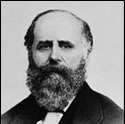Rowland Hussey Macy
| Rowland Hussey Macy | |
|---|---|
 | |
| Born |
August 30, 1822 Nantucket Island, Massachusetts |
| Died |
March 29, 1877 (aged 54) Paris |
| Cause of death | Bright's disease |
| Resting place | Woodlawn Cemetery |
| Nationality | American |
| Known for | R.H. Macy and Company |
| Spouse(s) | Louisa Houghton |
| Children |
Charles Macy (1845–1846) Rowland Hussey Macy, Jr. (1847–1878) Florence Macy (1853–1933), wife of James F. Sutton |
| Parent(s) |
John Macy (1786–1849) Elizabeth (née Myrick) Barnard (1790–1877) |
Rowland Hussey Macy, Sr. (August 30, 1822 – March 29, 1877) was an American businessman who founded the department store chain R.H. Macy and Company.
Life and career
Macy was the fourth of six children born to a Quaker family on Nantucket Island, Massachusetts. At the age of fifteen, he worked on the whaling ship Emily Morgan and had a red star tattooed on his hand, which became part of the store's logo.[1] He married Louisa Houghton (1820–1888) in 1844, and had three children: Charles A. Macy (1845-1846); Rowland Hussey Macy, Jr. (1847–1878); and Florence Macy (1853–1933), who married James F. Sutton.[2]
Between 1843 and 1855, Macy opened four retail dry goods stores, including the original Macy's store in downtown Haverhill, Massachusetts, established in 1851 to serve the mill industry employees of the area. They all failed, but he learned from his mistakes. Macy moved to New York City in 1858 and established a new store named "R.H Macy Dry Goods" at Sixth Avenue on the corner of 14th Street, significantly north of other dry goods stores of the time.[3][4] On the company's first day of business on October 28, 1858 sales totaled $11.08, equal to $303.00 today.
As the business grew, Macy's expanded into neighboring buildings, opening up more and more departments, and used publicity devices such as a store Santa Claus, themed exhibits, and illuminated window displays to draw in customers.[5] It offered a money back guarantee, although it only accepted cash into the 1950s. The store also produced its own made-to-measure clothing for both men and women, assembled in an on-site factory.[4]

In 1875, Macy took on two partners, Robert M. Valentine (1850–1879), a nephew; and Abiel T. La Forge (1842–1878) of Wisconsin, who was the husband of a cousin.[6][7]
Macy died on March 29, 1877 in Paris of Bright's disease.[8] He was interred in the Woodlawn Cemetery in The Bronx. His will was probated on May 1, 1877, and he left his wife, Louisa H. "absolutely, all the paraphernalia, wearing apparel, watches, rings, trinkets, jewels, and personal ornaments reputed to belong to her, and during her life, the use of all the household furniture, books, clocks, bronzes, and works of art". At her death this was to pass to his daughter Florence. He left only a small annuity for his son.[2] The following year, in 1878, Macy's partner La Forge died, and the third partner, Valentine, died in 1879.[6][7] Ownership of the store passed to the Macy's family until 1895, when it was sold to Isidor and Nathan Straus.
In popular culture
- Macy was portrayed in the 1947 movie Miracle on 34th Street by character actor Harry Antrim. In subsequent adaptations of the story, the character was played by Don Beddoe in an episode of The 20th Century-Fox Hour in 1955, Hiram Sherman in a 1959 TV movie, and David Doyle in a 1973 TV film.[9]
See also
- R.H. Macy and Company Store (building) for the history of the flagship store on Herald Square in Manhattan
- Macy's for a history of the chain
- Macy's, Inc. for a history of Federated Department Stores, owners of Macy's
References
Notes
- ↑ Evans, Stephen (2005-03-01). "The death of the department store". news.bbc.co.uk. BBC News. Retrieved 2008-11-02.
- 1 2 "Rowland H. Macy's Will". New York Times. May 1, 1877. Retrieved 2008-06-14.
The will of Rowland H. Macy, the well known Sixth-avenue merchant, has been filed in the Surrogate's Court. He leaves to his widow, Louisa H., "absolutely, all the paraphernalia, wearing apparel, watches, rings, trinkets, jewels, and personal ornaments reputed to belong to her, and during her life, the use of all the household furniture, books, clocks, bronzes, and works of art ...
- ↑ Robbins, L.H. (February 12, 1933). "The City Department Store: Evolution of 75 Years. The Macy Anniversary Directs Attention to the Development of The Great Institutions That Serve the American Shopper.". New York Times. Retrieved 2008-06-14.
For long after Captain Rowland H. Macy opened a fancy-goods shop in Sixth Avenue just below Fourteenth Street in 1858, seventy-five years ago, there was no department store in all the world. There were already merchant princes in New York, but they were specialists.
- 1 2 Abelson, Elaine S. "R. H. Macy" in Jackson, Kenneth T., ed. (2010), The Encyclopedia of New York City (2nd ed.), New Haven: Yale University Press, ISBN 978-0-300-11465-2, p.1102
- ↑ Burrows, Edwin G. & Wallace, Mike (1999), Gotham: A History of New York City to 1898, New York: Oxford University Press, ISBN 0-195-11634-8, pp.945-946
- 1 2 "Abiel T. La Forge". New York Times. February 13, 1878. Retrieved 2008-06-14.
- 1 2 "Robert M. Valentine's Will". New York Times. February 26, 1879. Retrieved 2008-06-14.
The will of Robert M. Valentine, late partner in the firm of R. H. Macy Co., was offered for probate yesterday in the Surrogate's office.
- ↑ "Rowland H. Macy, Merchant". New York Times. March 31, 1877. Retrieved 2008-06-14.
- ↑ "Mr. R.H. Macy" on IMDB
Further reading
- "Macy, R. H.". American National Biography. Oxford University Press. (subscription required)
- Hungerford, Edward "Early History of Macy's" in The Romance of a Great Store (1922)